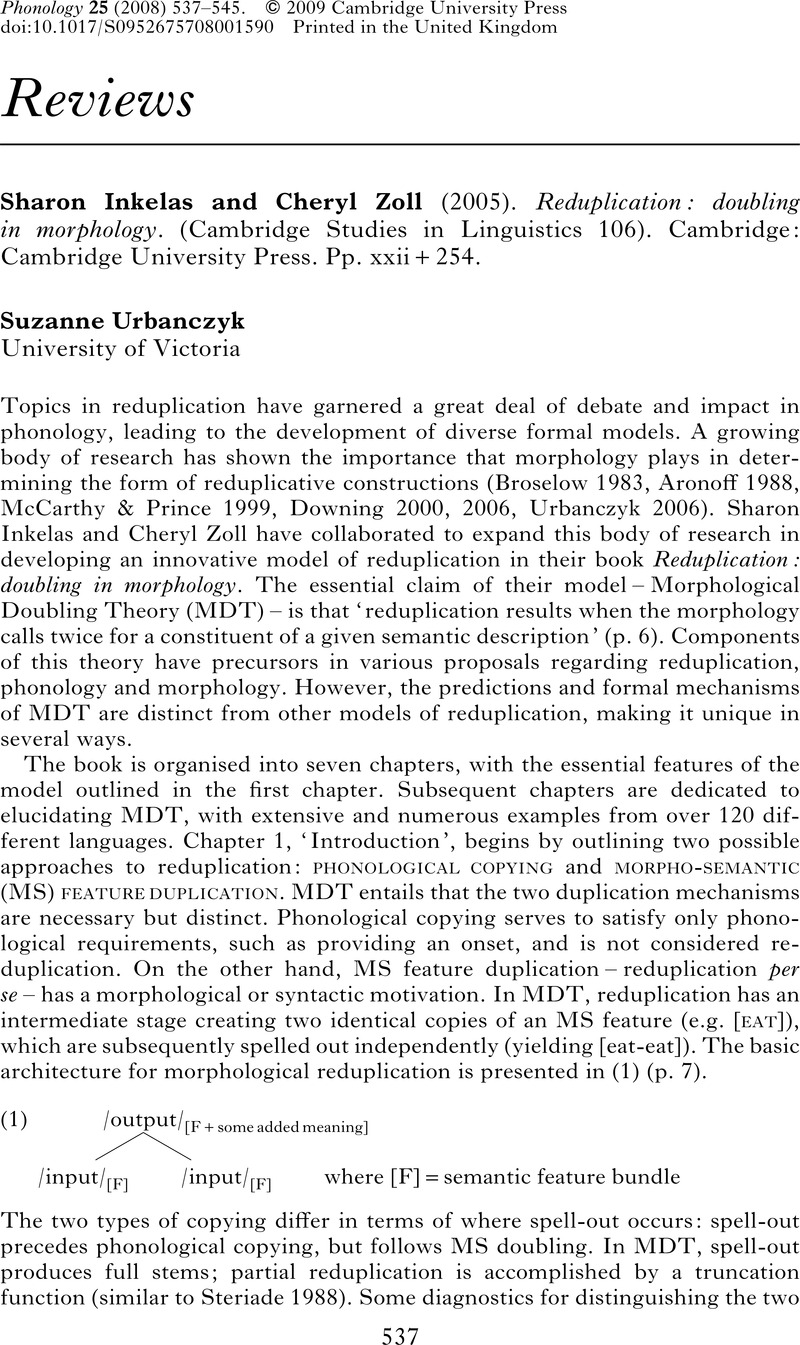No CrossRef data available.
Article contents
Sharon Inkelas and Cheryl Zoll (2005). Reduplication: doubling in morphology. (Cambridge Studies in Linguistics 106). Cambridge: Cambridge University Press. Pp. xxii+254.
Published online by Cambridge University Press: 24 February 2009
Abstract
An abstract is not available for this content so a preview has been provided. Please use the Get access link above for information on how to access this content.

- Type
- Book Review
- Information
- Copyright
- Copyright © 2009 Cambridge University Press
References
Alderete, John (2001). Dominance effects as transderivational anti-faithfulness. Phonology 18. 201–253.CrossRefGoogle Scholar
Aronoff, Mark (1988). Head operations and strata in reduplication: a linear treatment. Yearbook of Morphology 1. 1–15.Google Scholar
Beckman, Jill, Dickey, Laura Walsh & Urbanczyk, Suzanne (eds.) (1995). Papers in Optimality Theory. Amherst: GLSA.Google Scholar
Benua, Laura (1995). Identity effects in morphological truncation. In Beckman, et al. (1995). 77–136.Google Scholar
Broselow, Ellen (1983). Salish double reduplications: subjacency in morphology. NLLT 1. 317–346.Google Scholar
Broselow, Ellen & McCarthy, John J. (1983). A theory of internal reduplication. The Linguistic Review 3. 25–88.CrossRefGoogle Scholar
Burzio, Luigi (1994). Principles of English stress. Cambridge: Cambridge University Press.CrossRefGoogle Scholar
Bybee, Joan (1985). Morphology: a study of the relation between meaning and form. Amsterdam: Benjamins.CrossRefGoogle Scholar
Bybee, Joan (2001). Phonology and language use. Cambridge: Cambridge University Press.CrossRefGoogle Scholar
Clements, G. N. (1985). The problem of transfer in nonlinear morphology. Cornell Working Papers in Linguistics 7. 38–73.Google Scholar
Downing, Laura J. (2000). Morphological and prosodic constraints on Kinande verbal reduplication. Phonology 17. 1–38.CrossRefGoogle Scholar
Downing, Laura J. (2005). The emergence of the marked: tone in some African reduplicative systems. In Hurch, (2005). 89–110.Google Scholar
Downing, Laura J. (2006). Canonical forms in prosodic morphology. Oxford: Oxford University Press.CrossRefGoogle Scholar
Gouskova, Maria (2007). The reduplicative template in Tonkawa. Phonology 24. 367–396.CrossRefGoogle Scholar
Horwood, Graham (2001). Antifaithfulness and subtractive morphology. Ms, Rutgers University. Available as ROA-466 from the Rutgers Optimality Archive.Google Scholar
Hurch, Bernhard (ed.) (2005). Studies on reduplication. Berlin & New York: Mouton de Gruyter.CrossRefGoogle Scholar
Inkelas, Sharon (2008). The dual theory of reduplication. Linguistics 46. 351–401.CrossRefGoogle Scholar
Inkelas, Sharon & Zoll, Cheryl (2007). Is grammar dependence real? A comparison between cophonological and indexed constraint approaches to morphologically conditioned phonology. Linguistics 45. 133–171.CrossRefGoogle Scholar
Kurisu, Kazutaka (2001). The phonology of morpheme realization. PhD dissertation, University of California, Santa Cruz.Google Scholar
Łubowicz, Anna (2003). Contrast preservation in phonological mappings. PhD dissertation, University of Massachusetts, Amherst.Google Scholar
McCarthy, John J. & Prince, Alan (1995). Faithfulness and reduplicative identity. In Beckman, et al. (1995). 249–384.Google Scholar
McCarthy, John J. & Prince, Alan (1999). Faithfulness and identity in Prosodic Morphology. In Kager, René, van der Hulst, Harry & Zonneveld, Wim (eds.) The prosody–morphology interface. Cambridge: Cambridge University Press. 218–309.CrossRefGoogle Scholar
Matthews, P. H. (1974). Morphology: an introduction to the theory of word-structure. London: Cambridge University Press.Google Scholar
Mester, Armin (1986). Studies in tier structure. PhD dissertation, University of Massachusetts, Amherst.Google Scholar
Pater, Joe (to appear). Morpheme-specific phonology: constraint indexation and inconsistency resolution. In Parker, Steve (ed.) Phonological argumentation: essays on evidence and motivation. London: Equinox.Google Scholar
Raimy, Eric (2001). The phonology and morphology of reduplication. New York: Mouton de Gruyter.Google Scholar
Spaelti, Philip (1997). Dimensions of variation in multi-pattern reduplication. PhD dissertation, University of California, Santa Cruz.Google Scholar
Steriade, Donca (1988). Reduplication and syllable transfer in Sanskrit and elsewhere. Phonology 5. 73–155.CrossRefGoogle Scholar
Struijke, Caro (2000). Existential faithfulness: a study of reduplicative TETU, feature movement and dissimilation. PhD dissertation, University of Maryland, College Park.Google Scholar
Urbanczyk, Suzanne (2001). Patterns of reduplication in Lushootseed. New York: Garland.Google Scholar
Urbanczyk, Suzanne (2006). Reduplicative form and the root-affix asymmetry. NLLT 24. 179–240.Google Scholar
Wedel, Andrew (2007). Feedback and regularity in the lexicon. Phonology 24. 147–185.CrossRefGoogle Scholar
Wilbur, Ronnie (1973). The phonology of reduplication. PhD dissertation, University of Illinois at Urbana-Champaign.Google Scholar
Yip, Moira (1998). Identity avoidance in phonology and morphology. In Lapointe, Steven G., Brentari, Diane K. & Farrell, Patrick M. (eds.) Morphology and its relation to phonology and syntax. Stanford: CSLI. 216–246.Google Scholar




